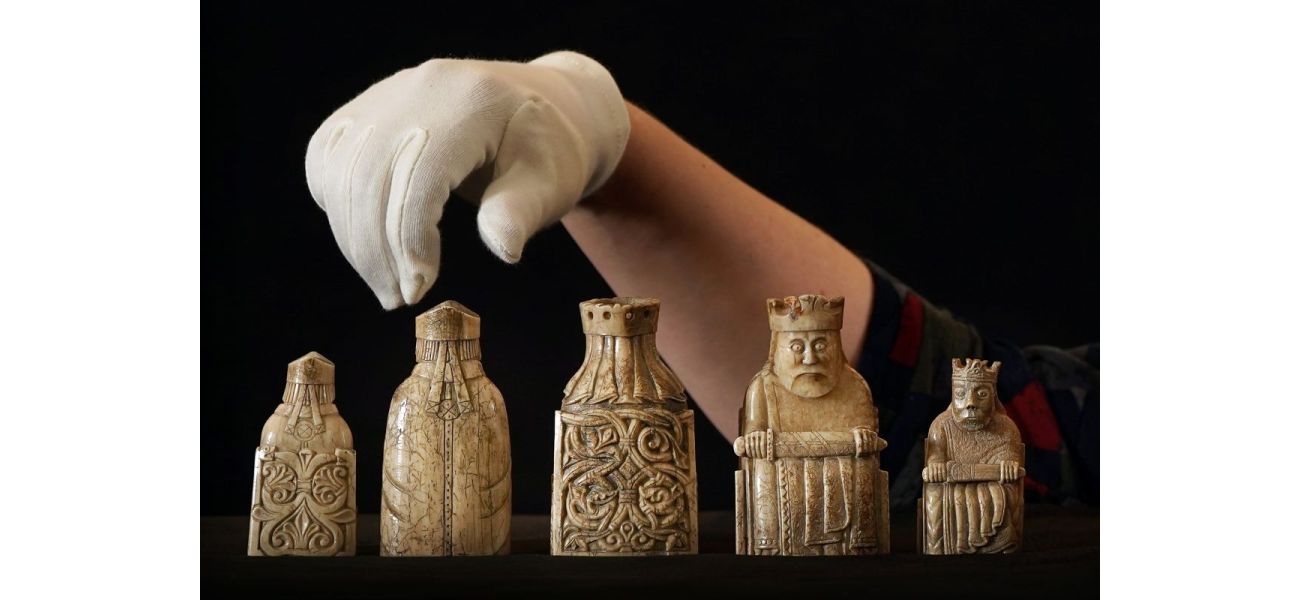Rare Lewis chess pieces now on display with view of their backs, a first for visitors.
The ancient Lewis chessmen are now shown in a case that reveals their backs, featuring characters like a wild-eyed warrior and a bored queen, made from walrus ivory and sperm whale teeth.
November 4th 2024.

The Lewis chessmen, a collection of intricately carved figures made from walrus ivory and sperm whale teeth, have been given a new display at the National Museum of Scotland in Edinburgh. This new display allows visitors to see the backs of the chessmen for the first time, giving a new perspective on these famous pieces.
Upon viewing the backs of these chessmen, one can appreciate the intricate details and designs that were previously unseen. The thrones, for example, feature complex vine scroll and interlace carvings, while the hair on some of the figures is depicted in stylized ringlets, adding to their charm and character.
It is believed that these chessmen were made in Norway around 1200 and were part of a larger hoard discovered on the Isle of Lewis in the early 19th century. At the time, Lewis was part of the Norse-Gaelic Kingdom of the Isles, which encompassed various islands and land along the west coast of Scotland and the Isle of Man. The Scandinavian influence in the region is evident in the intricate designs and craftsmanship of the chessmen.
The display of the chessmen at the National Museum of Scotland allows visitors to view them "in the round," giving a more complete understanding of the pieces and their historical significance. Dr Alice Blackwell, from National Museums Scotland, explains that these chessmen were designed to be appreciated from all angles, as each player sees the backs of their own pieces.
The hoard contained a total of 93 gaming pieces, including at least four chess sets and other games. Of these, 11 are in the collection of the National Museum of Scotland, while the remaining 82 are in the British Museum's collection. It is not known who buried the pieces or why, but it is thought that they may have been the property of a merchant traveling from Scandinavia to Scotland, Ireland, or the Isle of Man to sell these highly-prized playing sets.
These chessmen offer a fascinating insight into the popularity of chess in medieval Europe and the international connections of western Scotland during that period. Dr Blackwell notes that the intricately carved thrones on the backs of the chessmen suggest that they may have been the treasured possessions of a local prince, bishop, or other leader with close ties to Norway.
Overall, the new display of the Lewis chessmen at the National Museum of Scotland provides a unique opportunity for visitors to not only see these famous pieces, but also to gain a deeper understanding of their historical significance and the intricate details that make them so beloved.
Upon viewing the backs of these chessmen, one can appreciate the intricate details and designs that were previously unseen. The thrones, for example, feature complex vine scroll and interlace carvings, while the hair on some of the figures is depicted in stylized ringlets, adding to their charm and character.
It is believed that these chessmen were made in Norway around 1200 and were part of a larger hoard discovered on the Isle of Lewis in the early 19th century. At the time, Lewis was part of the Norse-Gaelic Kingdom of the Isles, which encompassed various islands and land along the west coast of Scotland and the Isle of Man. The Scandinavian influence in the region is evident in the intricate designs and craftsmanship of the chessmen.
The display of the chessmen at the National Museum of Scotland allows visitors to view them "in the round," giving a more complete understanding of the pieces and their historical significance. Dr Alice Blackwell, from National Museums Scotland, explains that these chessmen were designed to be appreciated from all angles, as each player sees the backs of their own pieces.
The hoard contained a total of 93 gaming pieces, including at least four chess sets and other games. Of these, 11 are in the collection of the National Museum of Scotland, while the remaining 82 are in the British Museum's collection. It is not known who buried the pieces or why, but it is thought that they may have been the property of a merchant traveling from Scandinavia to Scotland, Ireland, or the Isle of Man to sell these highly-prized playing sets.
These chessmen offer a fascinating insight into the popularity of chess in medieval Europe and the international connections of western Scotland during that period. Dr Blackwell notes that the intricately carved thrones on the backs of the chessmen suggest that they may have been the treasured possessions of a local prince, bishop, or other leader with close ties to Norway.
Overall, the new display of the Lewis chessmen at the National Museum of Scotland provides a unique opportunity for visitors to not only see these famous pieces, but also to gain a deeper understanding of their historical significance and the intricate details that make them so beloved.
[This article has been trending online recently and has been generated with AI. Your feed is customized.]
[Generative AI is experimental.]
0
0
Submit Comment





